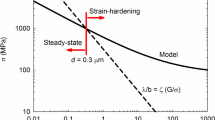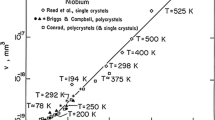Abstract
The dependence of the yield strength of metals on the grain size and initial dislocation density in a wide range of strain rates has been analyzed within a unified approach. It has been shown that the barrier stress and characteristic time of plastic relaxation completely determine the shear strength of metals for all strain rates. The existence of alternative (to dislocation glide) mechanisms of plastic deformation in the material, limits the increase in the yield strength with increasing strain rate and leads to the appearance of a maximum in the dependence of the yield strength on the grain size. It has been found that, at extremely high strain rates, the maximum yield strength corresponds to grain sizes of the order of several hundred nanometers. This has been explained by the dislocation starvation effect of the material.
Similar content being viewed by others
References
M. A. Shtremel’, Strength of Alloys: Part 2. Deformation (Moscow Institute of Steel and Alloys, Moscow, 1997) [in Russian].
M. A. Meyers and K. K. Chawla, Mechanical Behavior of Materials (Cambridge University Press, New York, 2009).
H. Gleiter and B. Chalmers, High-Angle Grain Boundaries (Pergamon, Oxford, 1972; Mir, Moscow, 1975).
J. W. Christian and S. Mahajan, Prog. Mater. Sci. 39, 1 (1995).
M. A. Meyers, Dynamic Behavior of Materials (Wiley, New York, 1994).
E. N. Borodin and A. E. Mayer, Phys. Solid State. 54(4), 808 (2012).
E. N. Borodin and A. E. Mayer, Mater. Sci. Eng., A 532, 245 (2012).
A. Yu. Kuksin, V. V. Stegailov, and A. V. Yanilkin, Phys. Solid State 50(11), 2069 (2008).
V. S. Krasnikov, A. E. Mayer, and A. P. Yalovets, Int. J. Plast. 27, 1294 (2011).
A. A. Gruzdkov, Yu. V. Petrov, and V. I. Smirnov, Phys. Solid State 44(11), 2080 (2002).
A. A. Gruzdkov, E. V. Sitnikova, N. F. Morozov, and Y. V. Petrov, Math. Mech. Solids 14, 72 (2009).
A. Gruzdkov and Y. Petrov, J. Ningbo Univ. (NSEE) 25, 78 (2012).
A. E. Dudorov and A. E. Maier, Vestn. Chelyab. Gos. Univ., Fiz. 39, 48 (2011).
A. E. Mayer, K. V. Khishchenko, P. R. Levashov, and P. N. Mayer, J. Appl. Phys. 113, 193508 (2013).
L. A. Merzhievsky and A. V. Tyagel’sky, J. Phys. (Paris) 49, C3–457 (1988).
L. D. Landau and E. M. Lifshitz, Course of Theoretical Physics, Vol. 7: Theory of Elasticity (Nauka, Moscow, 2003; Butterworth-Heinemann, Oxford, 2005).
Yu. N. Robotnov, Elements of Hereditary Solid Mechanics (Nauka, Moscow, 1977; Mir, Moscow, 1980).
Shock Waves and High-Strain-Rate Phenomena in Metals, Ed. by M. A. Meyers and L. E. Murr (Plenum, New York, 1981; Metallurgiya, Moscow, 1984).
J. R. Greer and J. Th. M. De Hosson, Prog. Mater. Sci. 56, 654 (2011).
R. W. Armstrong and F. J. Zerilli, J. Phys. D: Appl. Phys. 43, 492002 (2010).
M. A. Meyers, O. V. Hringer, and V. A. Lubarda, Acta Mater. 49, 4025 (2001).
S. Allain, J.-P. Chateau, and O. Bouaziz, Mater. Sci. Eng., A. 387–389, 143 (2004).
H. V. Swygenhoven and P. M. Derlet, Phys. Rev. B: Condens. Matter. 64, 224105 (2001).
D. McLean, Grain Boundaries in Metals (Clarendon, Oxford, 1957; Metallurgizdat, Moscow, 1960).
H. V. Swygenhoven and A. Caro, Phys. Rev. B: Condens. Matter 58, 11246 (1998).
J. P. Cui, Y. L. Hao, S. J. Li, M. L. Sui, D. X. Li, and R. Yang, Phys. Rev. Lett. 102, 045503 (2009).
G. E. Norman and A. V. Yanilkin, Phys. Solid State 53(8), 1614 (2011).
E. N. Borodin, S. A. Atroshenko, and A. E. Mayer, Tech. Phys. 59(8), 1163 (2014).
Y. M. Wang, E. M. Bringa, J. M. McNaney, M. Victoria, A. Caro, A. M. Hodge, R. Smith, B. Torralva, B. A. Remington, C. A. Schuh, H. Jamarkani, and M. A. Meyers, Appl. Phys. Lett. 88, 061917 (2006).
Author information
Authors and Affiliations
Corresponding author
Additional information
Original Russian Text © E.N. Borodin, A.E. Mayer, Yu.V. Petrov, A.A. Gruzdkov, 2014, published in Fizika Tverdogo Tela, 2014, Vol. 56, No. 12, pp. 2384–2393.
Rights and permissions
About this article
Cite this article
Borodin, E.N., Mayer, A.E., Petrov, Y.V. et al. Maximum yield strength under quasi-static and high-rate plastic deformation of metals. Phys. Solid State 56, 2470–2479 (2014). https://doi.org/10.1134/S1063783414120051
Received:
Published:
Issue Date:
DOI: https://doi.org/10.1134/S1063783414120051




